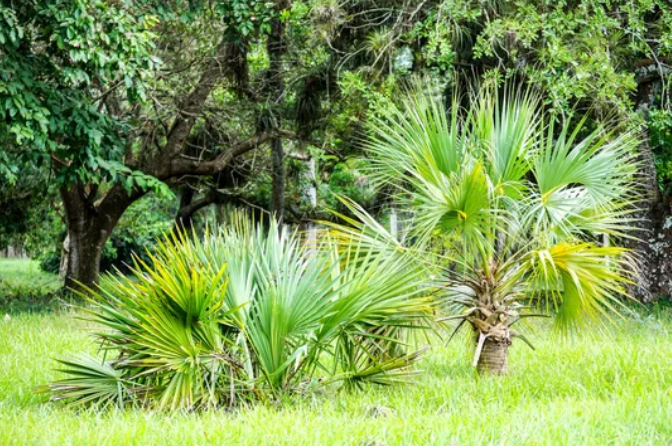
Unearth the best hardy palm trees that can thrive even in cold weather. Dive into our thorough guide that takes you through the hardiest varieties, offering crucial advice on their upkeep, planting, and nurturing. Turn your chill-prone backyard into a vibrant, tropical haven.
The outdoorsy ambiance is magically enhanced by the presence of palm trees. However, cultivating these tropical beauties can be challenging in climates that occasionally freeze.
Fret not, as particular frost-tolerant palms thrive in temperatures near freezing and can even endure brief snowy spells. Cold hardy palms may exhibit resilience to low temperatures.
Coconut palms grow solely in the southernmost areas of the United States, but numerous frost-resistant palm varieties flourish in colder climates.
Cold hardy palms may not survive winters in zones 5 to 7, but you could achieve favorable results with experimentation and care. To maximize success, select a variety best suited to your USDA growing zone, ensure the tree is mature to withstand harsh conditions better, position it in a wind-sheltered area, and keep it bone-dry in freezing temperatures.
Various cold-hardy palms include Lady Palm, Puerto Rican Thatch Palm, Date Palm, Queen Palm, Everglades Palm, California Fan Palm, Cabbage Palm, Chinese Fan Palm, European Fan Palm, Mexican Fan Palm, Saw Palmetto, Bismark Palm, Mexican Blue Palm, Guadalupe Palm, Jelly Palm, Chestnut Dioon, Chilean Wine Palm, Canary Island Date Palm, and Needle Palm.
These species offer various sizes, shapes, and characteristics, making them suitable for diverse landscapes and growing conditions. Each palm provides different levels of cold hardiness, with some able to withstand temperatures as low as -5 to -15 degrees Fahrenheit.
By selecting the right palm for your climate and providing appropriate care, you can enjoy the tropical ambiance of palm trees even in colder regions.
Best Hardy Palm Trees For Freezing Zones
If you live in a zone with freezing weather, you might think palm trees are out of your reach. However, some cold hardy palm trees can survive low temperatures and even snow. I will give you advice on growing cold-climate palm trees in this article.
Lady Palm (Rhapis excelsa)

The lady palm, also known as the bamboo palm, is a small, shrubby evergreen palm with bamboo-like stems. This shade-loving species has dark green, fan-shaped leaves and is very easy to grow.
It can withstand temperatures down to 18 degrees Fahrenheit. It grows well as an indoor palm, a foundation plant, or in mixed shrub borders in shady locations.
Puerto Rican Thatch Palm (Coccothrinax alta)
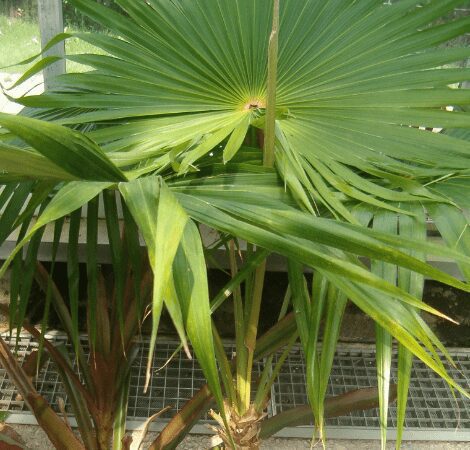
The Puerto Rican thatch palm, sometimes called the Barbados silver palm, is a palmate-leaved tree that can tolerate temperatures of 28–30 degrees Fahrenheit if the cold temperatures are limited in duration.
It does well in salt-wind conditions, making it a good choice for beachside landscaping. It has silvery-green leaves and produces small white flowers and black fruits.
Date Palm (Phoenix dactylifera)
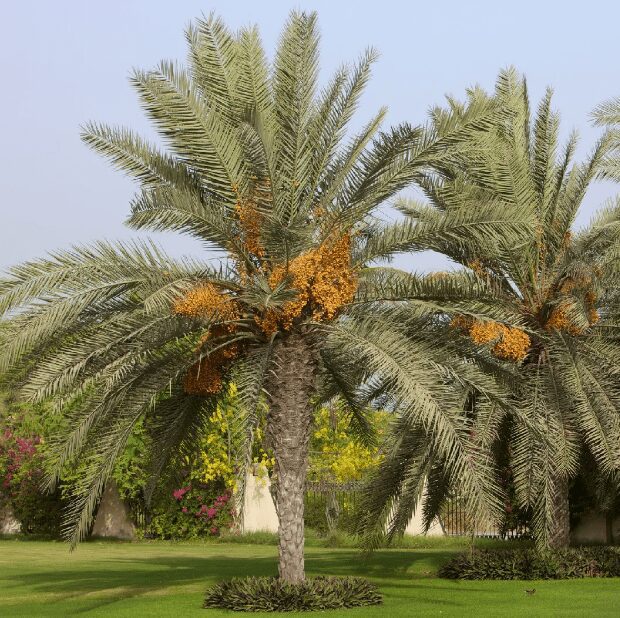
The date palm is a well-known palm tree that produces edible dates. It is native to the Middle East and North Africa and has been cultivated for thousands of years. It can tolerate temperatures down to 15 degrees Fahrenheit but needs a long and hot growing season to produce fruits. It has pinnate leaves with spiny leaflets and grows up to 75 feet tall.
Queen Palm (Syagrus romanzoffiana)
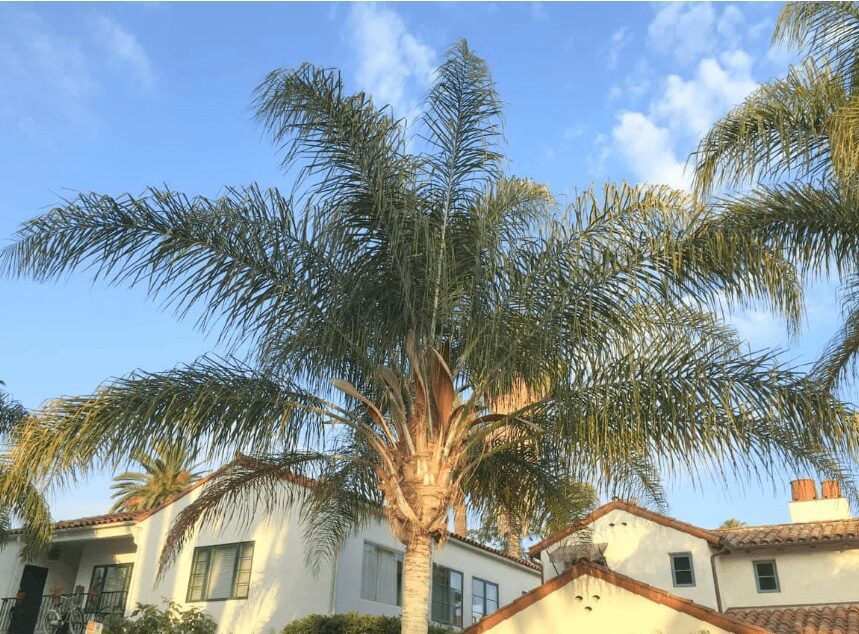
The queen palm is a graceful and elegant palm tree that can grow up to 50 feet tall. It has long and arching pinnate leaves with glossy green leaflets. It produces large clusters of orange fruits that attract birds and wildlife.
It can tolerate temperatures down to 20 degrees Fahrenheit but prefers warm and humid climates. It is often planted along streets, in parks, or as a specimen tree.
Everglades Palm (Acoelorrhaphe wrightii)
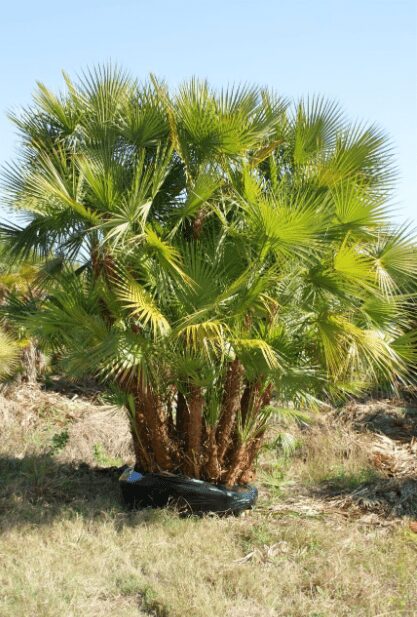
The Everglades palm, also known as the parotid palm or the silver saw palmetto, is a clustering palm that forms dense thickets. It has fan-shaped leaves with silvery undersides and sharp teeth along the leaf stems.
It produces small white flowers and purple fruits. It can tolerate temperatures down to 15 degrees Fahrenheit and is adaptable to wet or dry soils. It is native to Florida and the Caribbean and is often used for erosion control or wildlife habitat.
California Fan Palm (Washingtonia filifera)
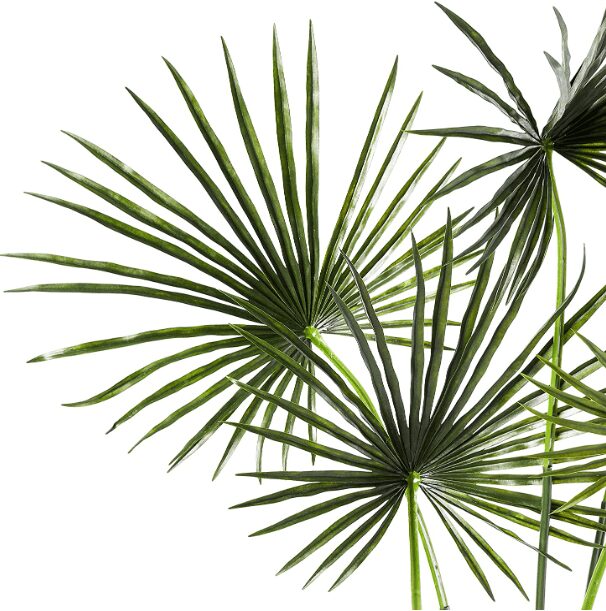
The California fan palm, also known as the desert fan palm or the petticoat palm, is a tall and robust palm tree that can grow up to 80 feet tall. It has large, round fan-shaped leaves with long, thread-like fibers hanging from the leaf margins.
It produces creamy-white flowers and black fruits. It can tolerate temperatures down to 10 degrees Fahrenheit and is very drought-tolerant. It is native to California and Arizona and is often found in oases or along streams.
Cabbage Palm (Sabal palmetto)
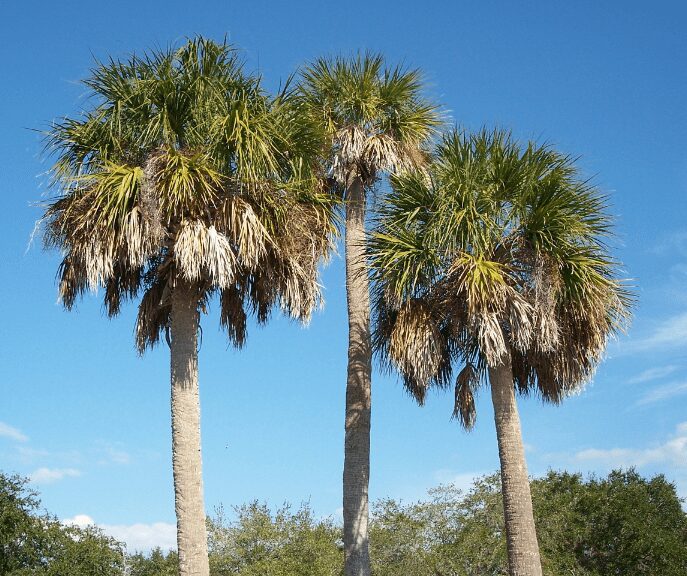
The cabbage palm, also known as the sabal palm or the palmetto, is a medium-sized palm tree growing up to 65 feet tall. It has costapalmate leaves with blue-green leaflets that form a round crown.
It produces white flowers and black edible fruits. It can tolerate temperatures down to 15 degrees Fahrenheit and is very salt and drought-tolerant. It is the state tree of Florida, where it’s widely cultivated.
Chinese Fan Palm (Livistona chinensis)
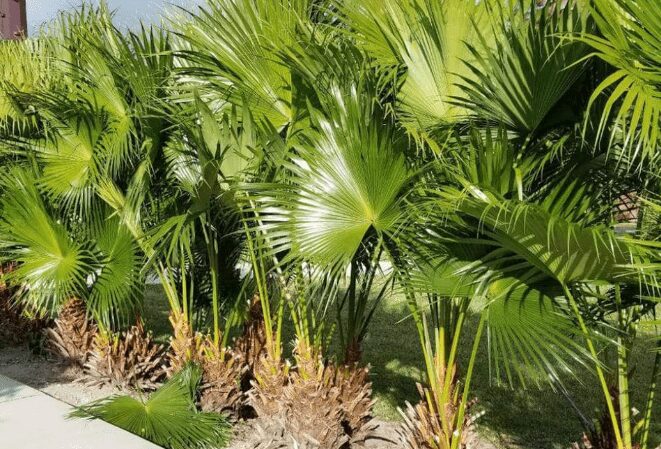
The Chinese fan palm, also known as the fountain palm or the Chinese fountain palm, is a slow-growing palm tree that can reach up to 40 feet tall. It has large and stiff fan-shaped leaves with drooping tips that create a fountain-like effect.
It produces yellow flowers and blue-black fruits. It can tolerate temperatures down to 15 degrees Fahrenheit and is moderately salt-tolerant. It is native to China and Japan and is often grown as an indoor or patio plant.

The European Fan Palm (Chamaerops humilis) is a hardy and versatile palm that can grow as a shrub or a small tree. It has fan-shaped leaves with spiny stems and yellow flowers in spring.
This Palm can tolerate cold, heat, drought, and salt and is native to the Mediterranean region. Best to be grown in full sun or partial shade, in well-drained soil, and with occasional watering. It is a slow-growing palm that can be pruned to remove suckers or to shape it.
A popular plant for adding a tropical touch to temperate gardens or growing in containers indoors or outdoors.
Growing Cold Hardy Palms
1. Choose the Right Variety
Not all palms are created equal when it comes to cold tolerance. Some, like the windmill palm (Trachycarpus fortunei) or needle palm (Rhapidophyllum hystrix), can withstand temperatures well below freezing. Research the hardiness zones of various palm varieties to ensure they suit your location.
2. Proper Planting
Plant your palm in a sunny location, as most palms prefer full sun. However, some species can tolerate partial shade. Make sure the soil is well-draining to avoid waterlogging, which can lead to root diseases.
3. Winter Protection
During the coldest months, consider providing some form of winter protection. Wrapping the trunk in burlap, applying a thick layer of mulch around the tree’s base, or using protective covers can make a significant difference.
4. Watering and Feeding
While cold hardy palms are generally drought-tolerant, they do appreciate regular watering during dry periods, especially when young. As for feeding, use a slow-release fertilizer explicitly formulated for palms containing essential micronutrients like magnesium and iron.
5. Pruning
Only prune dead fronds, as excessive pruning can harm the palm. Additionally, the fronds help protect the palm from cold temperatures.
6. Wind Protection
Strong winds can damage palm fronds and cause moisture loss. If you live in a windy area, consider planting your palm in a spot that’s shielded from the wind, or provide some form of windbreak.
7. Patience
Remember that many cold hardy palms, like the Bismarck palm or Chinese windmill palm, are slow growers. It might take several years for your palm to reach its mature size, but the wait is well worth it.
8. Pest and Disease Management
Watch for common palm pests like scale insects and spider mites. Regularly inspect the fronds for signs of disease, such as unusual spotting or discoloration.
9. Companion Planting
Consider pairing your palm with other plants that can provide extra protection from cold, like shrubs or groundcovers. They can also add visual interest and contribute to a healthy garden ecosystem.
10. Acclimatization
If you’re transplanting a palm, give it time to acclimate to its new environment. This is especially important if there’s a significant difference between the climate in its previous location and its new one.
By following these tips, you can enjoy palm trees’ beauty and tropical feel, even in cooler, non-tropical climates.
Final Word
Palm trees are not just for tropical or subtropical climates. Various palm species, commonly known as cold hardy palms, can withstand freezing temperatures and occasional snowfall, making them ideal for landscaping in colder regions.
These resilient trees, which include varieties like the Lady Palm, Date Palm, and European Fan Palm, among others, offer a taste of the tropics even in challenging climates.
Their unique aesthetic and ability to tolerate lower temperatures can enhance the beauty of your garden, creating a tropical oasis amid the cold.
It is essential, however, to select a variety that aligns with your specific USDA growing zone, provide it with optimal care, and protect it from extreme conditions to ensure its survival and growth.
Despite the challenges, the reward of having a thriving palm in your garden makes the effort worthwhile. So, don’t let cold weather deter you from enjoying these magnificent tropical trees.
Embrace the beauty of hardy palms and let them transform your landscape into a tropical paradise, regardless of the climate.
Bonus Closing Words
The world of cold hardy palm trees is extensive and fascinating, offering many species that can handle temperatures dipping far lower than most expect. From the evergreen palms like the Mexican fan palm and California fan palm to the uniquely attractive needle palm with its bushy appearance and the towering windmill palm tree, these varieties boast an impressive resilience to colder temperatures.
Some, like the Bismarck palm and the Pindo palm, even thrive in winter weather, with their large, dense crowns of feathery fronds showing little or no damage despite exposure to harsh conditions.
The European fan palm and Chinese windmill palm, both known for their fan-shaped fronds and slender trunks, are well-equipped to handle cold and are among the coldest hardy palms that one could grow. These are not the only options, though.
The Sabal minor, known as the dwarf palmetto, hails from the Southeastern United States and is another excellent choice. At the same time, the Phoenix canariensis, or Canary Island date palm, is a beautifully arching palm with a high canopy that originates from the Canary Islands but has been grown successfully in cooler climates like British Columbia.
Even in states like South Carolina and Michigan, or countries like Mexico and Brazil, where winter months can be harsh, palms such as the Mexican blue palm and Guadalupe’s palm have proven their hardiness.
Regions
They survive and thrive, contributing an exotic touch to the landscape. The Baja California region is home to the Washingtonia robusta, or the Mexican fan palm, a single-trunk palm known for its height and wind tolerance, as well as the Brahea armata, commonly known as the Mexican blue palm, recognized for its striking blue-green foliage.
While many of these palms are slow growers like the Rhapidophyllum hystrix, or needle palm, and Sabal texana, known for its massive leaves and high wind tolerance, there are fast-growing varieties too, like the Chilean wine palm or the Barbados silver palm, which add an instant tropical vibe.
From the southeast of the United States to northern Mexico, and even as far as central America and South America, these palms show admirable resilience.
Their attractive features, such as purple and yellow flowers, dark green or olive green leaves, and large, often palmate leaves, combined with their ability to survive in varying USDA zones, make them a popular choice for gardens, golf courses, and even as companion plants. Not to forget, their resilience extends beyond cold tolerance, including resistance to diseases, pests, and high winds.
To get the best out of these cold hardy palms, be it a slow-growing Bismarck palm with its silver-green leaves or a quick-to-establish Mexican fan palm, remember to consider their individual requirements for sunlight, water, and protection. Using mulch or wraps can provide additional winter protection, ensuring these beautiful plants continue to add a unique charm to your landscape despite the cooler climates.
So whether you’re in mountainous terrain like the Atlas mountains or a coastal region like New Jersey, or even in the desert regions of Southwestern United States, there’s a cold hardy palm tree suitable for your environment.
Each one, from the fast-growing Jelly palm to the slow but steady Butia capitata, carries with it an interesting piece of information, a bit of the world’s tropical experience, right into your yard, regardless of the colder climate.

























